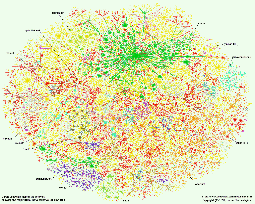Internet Atlas Gallery
Layout Showing the Major ISPs
Bill Cheswick, Bell Labs and Hal Burch, CMULucent Technologies Bell Labs Innovations
Carnegie Mellon University (CMU) Computer Science Dept.
URL: https://www.bell-labs.com/about/history/#gref
| Visualization Thumbnail | About the Data | ||||
|---|---|---|---|---|---|
 |
|
||||
| Full-Size Visualization | Back |

